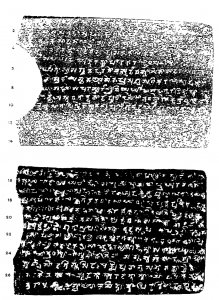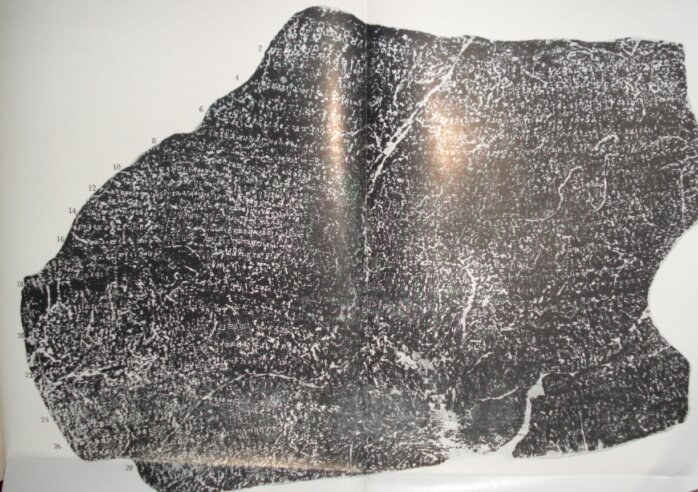Administrative Divisions in Gupta Empire
The inscriptions indicate a hierarchy of administrative divisions from top to bottom.
The territory of the empire is called & #39; rajya& #39;, & #39;rashtra& #39;, & #39;desa& #39; or & #39;mandala& #39;. The word & #39; prithvi& #39; is also used.
The inscriptions indicate a hierarchy of administrative divisions from top to bottom.
The territory of the empire is called & #39; rajya& #39;, & #39;rashtra& #39;, & #39;desa& #39; or & #39;mandala& #39;. The word & #39; prithvi& #39; is also used.
The Empire was divided into provinces.
A Province is called a & #39;Bhukti& #39; like & #39;Pundravardhana-Bhukti& #39; ( province of Bengal).
A province is also called a & #39;pradesa& #39; such as & #39;Airikina - pradesa& #39; ( District Sagar, MP).
A Province is called a & #39;Bhukti& #39; like & #39;Pundravardhana-Bhukti& #39; ( province of Bengal).
A province is also called a & #39;pradesa& #39; such as & #39;Airikina - pradesa& #39; ( District Sagar, MP).
Provincial Administration :-
The Head of the Province is called & #39;Uarika - Maharaja& #39; in the Damodarpur Copper Plate inscription.
He is also called & #39;Gopta& #39;, & #39;Bhogika& #39; or a & #39;Bhogapati& #39;.
The Head of the Province is called & #39;Uarika - Maharaja& #39; in the Damodarpur Copper Plate inscription.
He is also called & #39;Gopta& #39;, & #39;Bhogika& #39; or a & #39;Bhogapati& #39;.
Sometimes, the Governor may be King& #39;s son ( Rajputra Devabhattaraka) mentioned in the Damodarpur copper plate inscription of the year 533 AD.
The minister in attendance on the Royal Governor is called & #39;Kumaramatya& #39;.
Image of Damodarpur copper plate inscription of 533 AD.
The minister in attendance on the Royal Governor is called & #39;Kumaramatya& #39;.
Image of Damodarpur copper plate inscription of 533 AD.
The Head of the province was attended by a staff of private secretaries to act as intermediaries between him & the administration, & communicate his orders to them.
These were called & #39;Dutas& #39;, & #39;Dutakas& #39;, or & #39;Ajna - dapakas& #39;.
These were called & #39;Dutas& #39;, & #39;Dutakas& #39;, or & #39;Ajna - dapakas& #39;.
The provincial administration included the staff such as :-
1) & #39;Baladhikranika& #39; - the head of army,
2) & #39;Dandapasadhikarnika& #39; - chief of the police,
3) & #39;Ranabhandarika& #39; , the chancellor of military exchequer,
4) & #39;Mahadandanyaya& #39; - Chief Justice,
1) & #39;Baladhikranika& #39; - the head of army,
2) & #39;Dandapasadhikarnika& #39; - chief of the police,
3) & #39;Ranabhandarika& #39; , the chancellor of military exchequer,
4) & #39;Mahadandanyaya& #39; - Chief Justice,
5) & #39;Vinaya - sthithi- sthapaka& #39; - Minister of Law and order,
6) & #39;Bhatasvapati& #39; - Commander of Infantry and Cavalry.
6) & #39;Bhatasvapati& #39; - Commander of Infantry and Cavalry.
The commander of the Elephant force is also called & #39;Mahapilupati& #39; in the Gunaigarh Copper Plate inscription of Vainya Gupta, 188 Gupta Year, or 507 AD.
Image of Gunaigarh Copper Plate inscription
Image of Gunaigarh Copper Plate inscription
The Fardipur inscription of Dharmaditya mentions an officer called & #39;Sudhanika& #39; who had to deal with debt and finances, and hence was a judicial officer.
Image of Fardipur copper plate inscription
Image of Fardipur copper plate inscription
District Administration:-
The Head of the District is called & #39;Vishyapati& #39;. The headquarters of the district was named & #39;Adhisthana& #39;. The City Magistrate is also called & #39;Drangika& #39;.
The Head of the District is called & #39;Vishyapati& #39;. The headquarters of the district was named & #39;Adhisthana& #39;. The City Magistrate is also called & #39;Drangika& #39;.
The District record office is called & #39;Akshapatala& #39; under the departmental head called the & #39;Mahakshaptalika& #39;.
The Dept of Records comprised clerks who had to copy & write out records & documents. These writers are called & #39;Diviras& #39;, while the documents are called & #39;karanas& #39;.
The Dept of Records comprised clerks who had to copy & write out records & documents. These writers are called & #39;Diviras& #39;, while the documents are called & #39;karanas& #39;.
City Administration:-
There was a Mayor of the city who was called & #39; Purupalla& #39; ( Gunaigarh inscription), or & #39; Nagara- rakshka& #39;( Junagarh inscription).
There was also an officer who controlled the mayor of the different cities - & #39; Purapala - Uparika- - Pala& #39;.
There was a Mayor of the city who was called & #39; Purupalla& #39; ( Gunaigarh inscription), or & #39; Nagara- rakshka& #39;( Junagarh inscription).
There was also an officer who controlled the mayor of the different cities - & #39; Purapala - Uparika- - Pala& #39;.
A city was governed by a municipality called & #39; parishad& #39;. A city had a special officer or Superintendent of & #39;Dharmsalas& #39; called & #39; Avasathika& #39;.
The Paharpur Copper Plate inscription of Gupta year 159= 478 AD ( image), of Emperor Budha Gupta gives new details about local admin.
The Paharpur Copper Plate inscription of Gupta year 159= 478 AD ( image), of Emperor Budha Gupta gives new details about local admin.
It refers to the Executive Officers of the district as & #39; Ayuktas& #39; & to the city municipality as & #39; adhikarava& #39;, headed by a & #39; Puroga& #39; ( mayor).
Lastly, there were officers employed to stop mixing of castes, or inter-caste marriages.

 Read on Twitter
Read on Twitter









